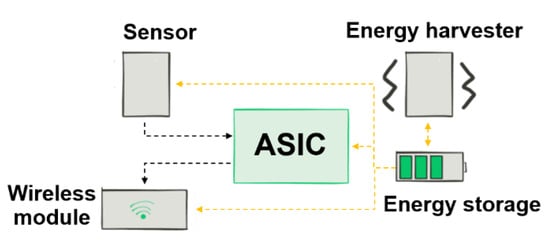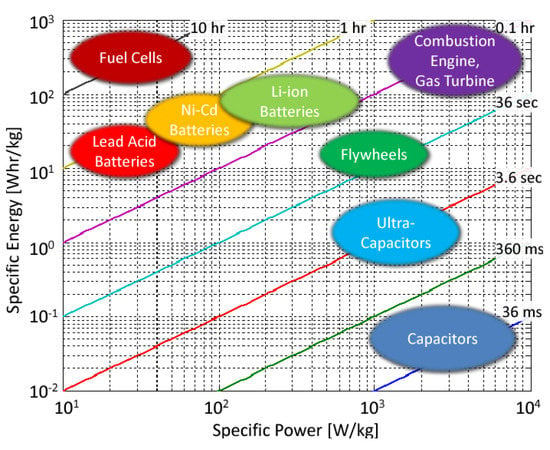Abstract
The current technological trends associated with Industry 4.0 and the Internet of Things (IoT) require an interconnected network of sensor nodes providing distributed information on the environment to enable intelligent action to be taken by control systems. Such sensors need to be wireless, self-powered and energy independent. In this work we provide an overview of possible strategies to realize a positive energy balance in autonomous sensor nodes without the use of batteries. We will first overview different sensors in terms of power consumption. We will then concentrate on energy harvesting and storage, showing state-of-the-art possibilities in both cases.
1. Introduction
The realization of greenhouse gas (GHG) emission reduction goals is related with improving the efficiency and reliability of the industrial and transport sectors. Distributed, wireless sensor networks (WSN) are the key enablers for this task. For example, air quality monitoring can improve the efficiency of indoor air conditioning systems; vibration sensing in machines and vehicles allows predictive maintenance with consequent improved efficiency and reduction of fuel consumption. WSN need thus to be distributed in the environment, for instance being attached to building walls or fixed inside machine casings, all cases in which a wired connection is impossible, and accessibility to replace batteries is limited. Autonomous, energy-independent sensor nodes are thus necessary.
2. Autonomous Sensor Nodes
Autonomous wireless sensor nodes are composed by several elements (cf. Figure 1). The sensor itself could be a metal-oxide gas sensor, a vibration or pressure sensor, a temperature sensor, and so on. Depending on sensor type, also the power consumption of the sensor can be determined. Metal oxide gas sensors require heating up to 400 °C to function, so high power consumption can be expected [1]. Vibration or temperature sensors generally consume less power. Additionally, the ASIC (needed for power conditioning and for data collection/transmission) and the wireless module (the antenna) are power-consuming elements. In order for the sensor node to be energy autonomous, the energy supply system must be able to generate (and store) a surplus of energy between each working cycle of the sensor node.

Figure 1.
Example of an autonomous wireless sensor node composed of the sensor proper, the wireless module, an Application-Specific Integrated Circuit (ASIC) and an energy supply system.
3. Energy Supply Systems for Autonomous Sensor Nodes
The energy supply system is constituted by an energy harvester and an energy storage device. Typical energy harvesting devices are: photovoltaic cells, piezoelectric energy harvesters, thermoelectric energy harvesters, and triboelectric energy harvesters. The main requirement for the energy harvester is that the produced power is in excess of the consumed one, but the harvesting strategy depends much on the sensor’s location and boundary conditions. For example, a photovoltaic cell is not suitable for embedded applications where no light is available; triboelectric harvesters are more efficient than piezoelectric ones for low-frequency applications [2].
Energy storage elements, on the other hand, need to be able to quickly charge/discharge since the harvested energy source has high variability (e.g., wind, solar light). They need also to supply power during long unavailability periods of the energy source (e.g., during the night). They need thus to combine high power density with high energy density. From the Ragone plot (Figure 2) it is clear that no such device exists. That is, a combination of devices (e.g., a capacitor with a battery) or improved devices (e.g., a capacitor or supercapacitor with high energy density) are the way to go.

Figure 2.
Ragone plot for the classification of energy storage devices with respect to their energy vs. power density (©2020 IEEE. Reprinted, with permission, from [3]).
In this work, we will present a few promising strategies for supplying energy to autonomous sensor nodes, including piezoelectric and triboelectric energy harvesters, high energy density capacitors, and solid-state batteries.
Funding
This project has received funding from the European Research Council (ERC) under the European Union’s Horizon 2020 research and innovation program (grant agreement No. 817190).
Conflicts of Interest
The authors declare no conflict of interest. The funders had no role in the design of the study; in the collection, analyses, or interpretation of data; in the writing of the manuscript, or in the decision to publish the results.
References
- Baranov, B.; Spirjakin, D.; Akbari, S.; Somonov, A. Optimization power consumption for gas sensor nodes: A survey. Sens. Act. A 2015, 233, 279–289. [Google Scholar] [CrossRef]
- Wang, Z.L. Triboelectric nanogenerators as new energy technology and self-powered sensors–Principles, problems and perspectives. Faraday Discuss. 2014, 176, 447–458. [Google Scholar] [CrossRef] [PubMed]
- Moura, S.J.; Siegel, J.B.; Siegel, D.J.; Fathy, H.K.; Stefanopoulou, A.G. Education on vehicle electrification: Battery Systems, Fuel Cells, and Hydrogen. In Proceedings of the IEEE Vehicle Power and Propulsion Conference 2010, Lille, France, 1–3 September 2010; IEEE: Piscataway, NJ, USA, 2010. [Google Scholar]
Publisher’s Note: MDPI stays neutral with regard to jurisdictional claims in published maps and institutional affiliations. |
© 2020 by the authors. Licensee MDPI, Basel, Switzerland. This article is an open access article distributed under the terms and conditions of the Creative Commons Attribution (CC BY) license (https://creativecommons.org/licenses/by/4.0/).